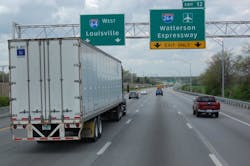Yet fatigue isn’t trucking’s issue alone – indeed, it’s been cited as a safety concern for the everyday motorist as well.
But here’s the rub, if you will: what EXACTLY is “fatigue” anyways? More importantly, what causes it, how can it be counteracted, and how does it impact a human being’s ability to safely perform any number of tasks – including operating a motor vehicle?
To that end, one of the long-time experts on fatigue – Dr. Martin Moore-Ede – recently penned a “white paper” to encapsulate the “fundamentals of fatigue” (if you will) for the general public. The good doctor knows what he’s talking about, by the way, for he dealt first-hand with challenges of fatigue as a surgeon-in-training working 36-hour shifts when he became his medical career more than three decades ago.Based on his residency experience, Dr. Moore-Ede (at left) went on to research the challenges of living, working, and sleeping in a 24 hour-a-day, 7-day-a-week world.
Then, while serving as a Harvard Medical School professor from 1975 to 1998, he led a team that discovered the biological clock in the human brain that controls the timing of sleep and wakefulness.
As a result, he founded the Circadian consulting company in 1983 to help a variety of industries – but especially transportation-oriented ones – help their employees safely adapt to working around the clock while sustaining optimum physical and mental performance.
[Various technologies are being deployed to help combat truck driver fatigue, as well.]
“Fatigue is an impairment of mental and physical function manifested by a cluster of debilitating symptoms, usually including excessive sleepiness, reduced physical and mental performance ability, depressed mood and loss of motivation,” Dr. Moore-Ede wrote.
That being said, there is no single root cause of fatigue. Indeed, it can result from a variety of causes, including:
- Sleep deprivation: Fatigue develops as the result of an extended time period spent awake (acute sleep deprivation), reduced time asleep, disrupted or poor quality sleep (partial sleep deprivation), or from the cumulative effect of multiple days with shortened or disrupted sleep such as may occur in jobs with extended work hours or with night shift work (chronic sleep deprivation).
- Sleep disorders: Fatigue manifested as excessive daytime sleepiness is the most common presenting complaint in sleep disorders, such as obstructive sleep apnea, restless legs syndrome, narcolepsy or most of the other 85 different sleep disorders listed in the International Classification of Sleep Disorders (ICSD).
- Illness or disease: Fatigue is common in many diseases and illnesses ranging from flu to cancer that may occur as a direct result of the metabolic or other systemic “pathophysiological” disturbances of that disease, as a secondary consequence of sleep disturbances caused by other symptoms such as pain, nausea, etc., or as the primary presenting complaint (e.g. chronic fatigue syndrome).
- Therapeutic Side-Effect: Fatigue is a commonly listed side-effect of prescription or over-the-counter pharmacological drugs, or may occur as the result of other therapeutic interventions (e.g. the aftereffect of a surgical procedure).
- Heavy Stressful Physical or Mental Exertion: Fatigue occurs as the result of extended hours of work with heavy muscular activity (e.g. lumberjack or marathon runner), continued stress or danger (e.g. combat fatigue) or intense mental exertion (student taking examinations) which occurs either during the task or as a rebound effect after the task, in proportion to the relative fitness (and/or prior training) of the individual.
- Stimulant Drug Usage: Fatigue often occurs as a person rebounds after the initial euphoria or "high" induced by illegal or prescription stimulant pharmacological substances.
“Because there are multiple aspects of fatigue, it is often helpful to more precisely define fatigue either in terms of the predominant symptom (e.g. excessive sleepiness), the cause (e.g. obstructive sleep apnea), the body system predominantly involved (e.g. mental fatigue), or the outcome risk (e.g. driver fatigue),” he explained.
One way fatigue can be precisely defined and measured is in terms of its most common and easily measurable symptom: what he dubs “excessive sleepiness.”
“’Excessive sleepiness’ can be measured by a variety of subjective (e.g. Epworth Score) and objective tests including the Multiple Sleep Latency Test (MSLT), the Maintenance of Wakefulness Test (MWT) and measurement of the frequency and duration of ‘micro-sleep’ lapses – very short lapses into sleep of typically 2-20 seconds in length in the middle of periods of wakefulness,” Dr. Moore-Ede said.
This definition of fatigue in terms of "excessive sleepiness" is particularly useful, he added, and as a result has become widely accepted in a number of key areas:
- Medical Diagnosis: Approximately 85 specific sleep disorders and multiple other conditions which cause excessive sleepiness are defined in the ICSD.
- Regulatory Agency Approval of Prescription Drugs: The treatment of excessive sleepiness per se, without addressing the underlying etiology, is now an accepted rationale in prescription drug regulations (e.g. FDA or Health Canada approval of Modafinil for the treatment of excessive sleepiness).
- Public Policy and Work/Rest Hours Regulation: There is a broad body of regulations in certain industries, including transportation, which govern hours of work and rest so as to prevent excessive sleepiness and fatigue. For truckers, that directly connects to the FMCSA’s or Transport Canada’s HOS regulations of truck drivers designed to prevent driver fatigue by protecting time off-duty available for sleep and encouraging drivers to use it.
- Criminal Laws: A criminal statute was enacted and signed into law in New Jersey in 2004 – with similar legislation proposed in various other states – with fatigue impairment and excessive sleepiness caused by extended periods of time awake being equated in terms of legal penalty to impairment caused by drug or alcohol intoxication.
“As a result, fatigue and its major symptom of ‘excessive sleepiness’ is now well recognized in law and regulation as a significant body impairment, malfunction and source of ill-health and of accident and injury risk,” Dr. Moore-Ede said.
End result for trucking: fatigue is going to remain a focal point of both regulatory and safety initiatives within this industry well into the future.



